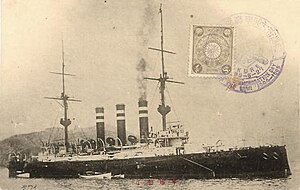Japanese cruiser Iwate

A postcard of Iwate at anchor, 1905
|
|
| History | |
|---|---|
|
|
|
| Name: | Iwate |
| Namesake: | Iwate Prefecture |
| Ordered: | 19 July 1898 |
| Builder: | Armstrong Whitworth, United Kingdom |
| Laid down: | 11 November 1898 |
| Launched: | 29 March 1900 |
| Completed: | 18 March 1901 |
| Reclassified: |
|
| Struck: | 30 November 1945 |
| Fate: |
|
| General characteristics | |
| Class and type: | Izumo-class armored cruiser |
| Displacement: | 9,423 t (9,274 long tons) |
| Length: | 132.28 m (434 ft 0 in) (o/a) |
| Beam: | 20.94 m (68 ft 8 in) |
| Draft: | 7.21 m (23 ft 8 in) |
| Installed power: |
|
| Propulsion: |
|
| Speed: | 20.75 knots (38.43 km/h; 23.88 mph) |
| Range: | 7,000 nmi (13,000 km; 8,100 mi) at 10 knots (19 km/h; 12 mph) |
| Complement: | 672 |
| Armament: |
|
| Armor: |
|
Iwate (磐手?) was the second and last Izumo-class armored cruiser built for the Imperial Japanese Navy (IJN) in the late 1890s. As Japan lacked the industrial capacity to build such warships herself, the ship was built in Britain. She participated in most of the naval battles of the Russo-Japanese War of 1904–05. The ship was moderately damaged during the Battle of Port Arthur, the Battle off Ulsan, and the Battle of Tsushima. Iwate played a minor role in World War I and began the first of her many training cruises for naval cadets in 1916, a task that would last until the end of 1939. The ship continued to conduct training in home waters throughout the Pacific War. Iwate was sunk by American carrier aircraft during the attack on Kure in July 1945. Her wreck was refloated and scrapped in 1946–47.
The 1896 Naval Expansion Plan was made after the First Sino-Japanese War and included four armored cruisers in addition to four more battleships, all of which had to be ordered from British shipyards as Japan lacked the capability to build them itself. Further consideration of the Russian building program caused the IJN to believe that the battleships ordered under the original plan would not be sufficient to counter the Imperial Russian Navy. Budgetary limitations prevented ordering more battleships and the IJN decided to expand the number of more affordable armored cruisers to be ordered from four to six ships. The revised plan is commonly known as the "Six-Six Fleet". Unlike most of their contemporaries which were designed for commerce raiding or to defend colonies and trade routes, Iwate and her half-sisters were intended as fleet scouts and to be employed in the battleline.
...
Wikipedia
